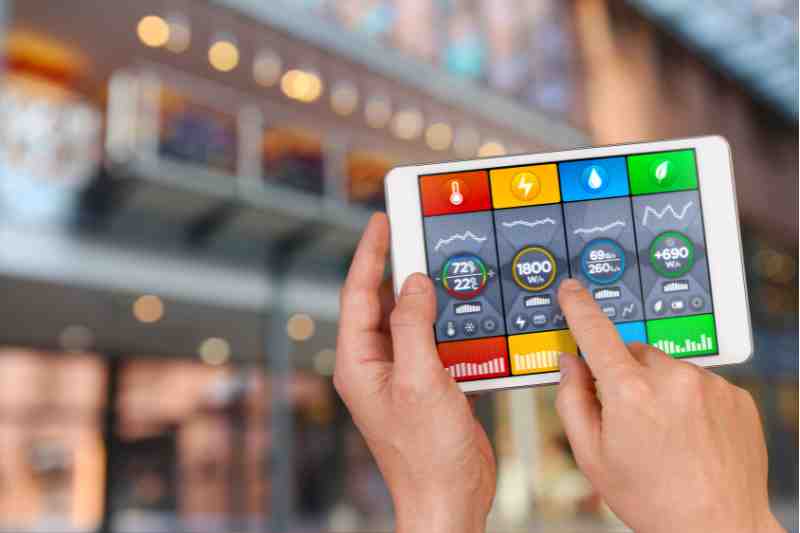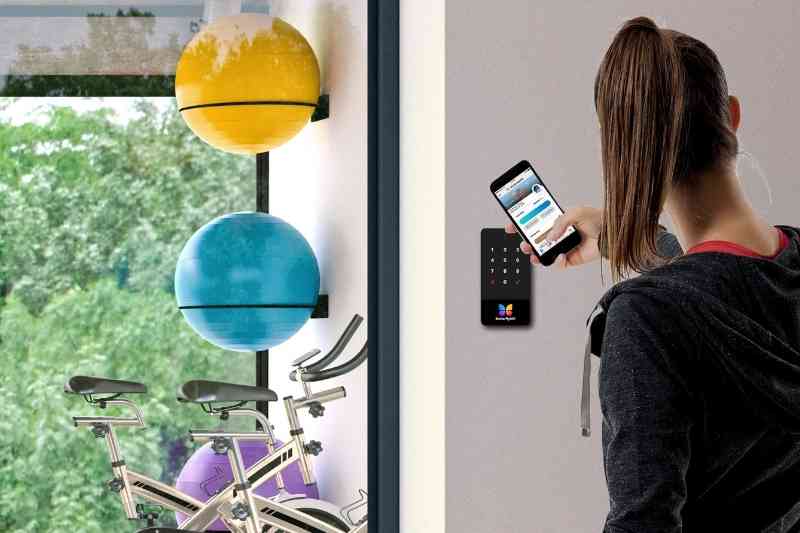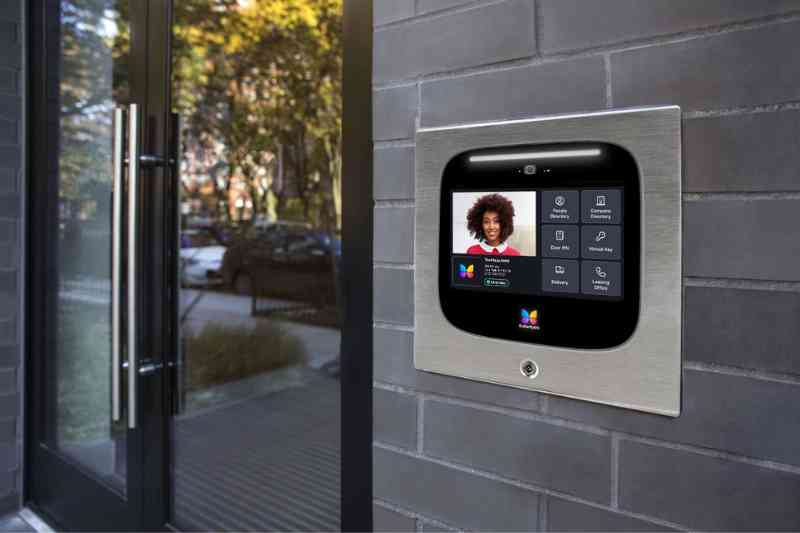Takeaways
- Building automation is the process of using smart technology to make a building easier to operate.
- Building automation software uses the Internet of Things (IoT). This allows sensors attached to building infrastructure to gather information and make their own decisions.
- Building automation benefits include keeping tenants safe, cutting costs, and saving time for staff members.
- You can use building automation solutions to upgrade your building’s HVAC, lighting, and access control, among other systems.

Owning or operating a successful building means staying on top of the trends and technological innovations that are changing the face of real estate. And one trend that properties across the nation are embracing is smart building automation. Building automation saves money for ownership and time for staff and increases tenant satisfaction. But what is it, and how does it work?
In this post, we explain what building automation is and its benefits. Then, we go over examples of automation in buildings that you can use on your property.
This post covers:
- What is building automation?
- How does building automation work?
- What are some examples of building automation systems?
- What are the main benefits of building automation?
- Building automation FAQs
What is building automation?
Building automation is the process of using technology to simplify day-to-day building operations.
There’s a lot of work that goes into running a building. It’s not just keeping tenants happy with excellent customer service. Behind the scenes, property managers are also in charge of crucial infrastructures like utilities, HVAC, heating, and lighting. Keeping tabs on all of these systems is enough to make anybody’s head spin.
But these days, advances in technology like sensors and the Internet of Things mean every part of a building’s infrastructure can be upgraded. As a result, intelligent buildings can exchange information and make smarter, data-backed decisions. So, the building itself can begin to take on some of the burdens of management and administration and unlock tons of new benefits.
The four main BAS control models
Here are the four main ways to control building automation:
- Centralized BAS. All control and monitoring functions are managed from a single central system or server.
- Decentralized BAS. Control and monitoring are distributed across multiple independent systems or controllers.
- Distributed BAS. A hybrid model where control and monitoring are split between a central system and several distributed controllers.
- Open BAS. Uses open protocols and standards, allowing easier integration with third-party devices and systems.
Learn how to automate your apartment building:
How does building automation work?
Building automation systems (BAS) work by integrating various building systems — such as lighting, heating, ventilation, air conditioning (HVAC), security, and energy management — into a unified platform. This integration allows you and your team to control and monitor these systems more efficiently. This ensures optimal performance, energy savings, and enhanced comfort for everyone at your property.
Here’s how building automation works, step by step:
- Sensors and data collection. The system starts by using sensors installed throughout the building to collect real-time data. These sensors track variables such as temperature, humidity, light levels, occupancy, air quality, and energy usage. For example, occupancy sensors detect whether a room is in use and adjusts HVAC or lighting systems accordingly to conserve energy.
- Central management systems. The data from sensors is sent to a central management system, where it is processed and analyzed. This system acts as the “brain” of the building automation and makes decisions about how different systems should operate based on the data it receives. In some models, control may be distributed across multiple units or devices, but all systems work together to achieve coordinated control.
- Data analytics and reporting. Advanced BAS includes built-in analytics that track system performance, energy consumption, and other critical metrics. This data is often used to generate reports that help you identify areas for improvement, reduce waste, and ensure your systems are running at peak efficiency. Predictive maintenance is another key feature, where the system can alert you about potential failures before they occur.
What are some examples of building automation systems?
Here are some building automation system examples:
1. HVAC
If a building’s ventilation system isn’t working properly, residents run the risk of developing mold-related health problems.
However, automation can revolutionize your HVAC system. Ventilation-specific sensors can detect changes in humidity, temperature, airflow, and other variables. These sensors can also detect mold and notify you before it becomes a problem.
2. Lighting
Your building’s lights are one of the most efficient places to set up an automation system.
At first glance, you may not see lighting as an important building management aspect. But when do you actually need your lights to be on? If you’re getting enough natural light, or if there aren’t any people in a certain area, you don’t need to waste electricity lighting those rooms.
This is where controlled automation comes in. With the help of sensors and light-detecting smart glass, you can light up rooms and floors only when in use — saving you money on your power bill.
3. Access control
Remember: Building automation doesn’t just affect pipes and other infrastructure that tenants never see. With the right technology, your tenants can experience the benefits of real estate automation firsthand. For example, you can automate your building with intercoms and keypads that allow tenants to unlock doors with a tap of their smartphones.
In the days of analog access control, staff members had to spend hours printing out credentials and assigning them to residents. Then, they had to take them back at the end of a tenant’s stay.
But now, tenants can use their smartphones to instantly let themselves in. Further, they can create Visitor Passes for guests, creating a seamless access experience while staff directs their energies elsewhere.
Integrating access control with building automation
Integrating access control systems like ButterflyMX with your building automation system is a smart way to centralize control and improve security while enhancing efficiency.
Here’s how you can integrate access control with building automation:
- Centralized control. By integrating ButterflyMX’s Video Intercom system with your building’s automation platform, you can control access points alongside other building systems from a single dashboard. This streamlines operations, as staff can monitor security and manage access all in one place. This greatly reduces the complexity and time spent navigating multiple platforms.
- Automated access scheduling. Property managers can schedule access permissions for tenants, visitors, and contractors in sync with other automated systems. For instance, you can send a Delivery Pass to couriers when a package delivery is expected. This integration enhances both security and convenience while ensuring that only authorized individuals can enter the premises during designated times.
- Real-time monitoring and alerts. Integrated systems provide you with real-time data on who enters and exits your building, alongside alerts for unusual activities such as unauthorized access attempts. This allows for quicker responses to security threats and improves the overall safety of your building.
- Mobile access. By incorporating ButterflyMX’s mobile app into your automation system, you and your tenants can manage access from your smartphones. Whether it’s granting visitor access or tracking deliveries, mobile access ensures flexibility and efficiency, making access easier for everyone at your property.

What are the main benefits of building automation?
Building automation has benefits for staff and tenants alike.
A smart building management system benefits you by:
Keeping your tenants safer
Your tenants depend on your building’s infrastructure to stay healthy and safe.
Here’s one example of building automation keeping tenants safe:
Instead of doing routine checks on your building’s plumbing system to ensure everything is in order, you can install smart home sensors instead. These sensors will automatically detect structural failures and send you an automatic notification, reducing the time you spend on maintenance. And the best electronic control systems will even automatically shut down your plumbing system in the event of an imminent failure. As a result, you’ll create a safeguard that your residents will appreciate.
How ButterflyMX improves safety and security at your property
Building automation integrates multiple security systems into one cohesive platform. Smart locks, cameras, and access control systems work together to provide you insights into the people entering and exiting your property. Building automation systems also send alerts for unusual activity or safety concerns, such as unauthorized access or potential fire hazards.
ButterflyMX is a prime example of a solution that enhances security at your property. As part of the broader ecosystem, ButterflyMX integrates seamlessly with other building automation systems to offer a unified access control solution. With ButterflyMX’s Video Intercom, you can monitor and control access points remotely, grant entry to residents and visitors through their smartphones, and even manage package deliveries securely.
For residential properties, this provides an easy, secure way for residents to control access to their building and individual units without the need for physical keys. For commercial properties, it offers you greater control over access, including secure entry for employees, contractors, and visitors, all while maintaining a high level of security.

Lowering maintenance costs
Sensors that give you status updates on infrastructure save you money as well as time.
You might be able to count on staff members to do routine checks. However, you’re still taking them away from other duties for a task they’ll have to repeat over and over. So, maintenance is the perfect task to automate. Furthermore, by making your staff members more efficient, you make them more cost-effective.
Saving time for staff
By automating your building, you can free staff members from routine, mundane tasks—whether those tasks involve managing tenant experiences or keeping building infrastructure updated.
When staff members have administrative and routine busywork taken off their plates, they can dedicate their time to delighting residents with personalized service. Residents who feel appreciated and have positive impressions of their building are more likely to renew their leases.
How ButterflyMX streamlines property management
For property managers, building automation systems offer an opportunity to streamline operations and improve the efficiency of property management tasks. Through automation with ButterflyMX, you can remotely monitor access and make adjustments to access permissions as needed. What’s more, these systems can alert your team to issues before they escalate, such as security breaches, allowing them to address problems proactively.
For residential properties, this means fewer complaints from residents and more efficient operations. For commercial properties, you can maintain control over large, multi-building portfolios without being on-site every day.

Energy savings
One of the most significant benefits of building automation is its ability to optimize energy usage. Automated systems can control heating, ventilation, air conditioning (HVAC), lighting, and other systems based on real-time data and occupancy patterns. This level of control leads to energy savings and reduced utility costs by ensuring that resources are only used when necessary.
For example, smart apartment technology, like automated lighting systems, can be programmed to turn off when rooms are unoccupied, and HVAC building automation systems can adjust based on the time of day or occupancy.
For residential properties, this means that tenants experience lower energy bills, while commercial properties can significantly reduce operational costs.
Building automation FAQs
- Is building automation new?
- How much does a building automation system cost?
- What is the life expectancy of a building automation system?
- What is the difference between BAS and BMS?
Is building automation new?
While building automation sounds new, it’s actually centuries old. The automation part of the phrase doesn’t refer to the latest technological advances. Rather, automation refers to any form of smart building technology that replaces a manual process. For example, the thermostat was patented in 1886 and is one of the first examples of automation in buildings.
How much does a building automation system cost?
Costs vary widely depending on the type of building automation system that you install. Generally, the cost is between $2.50 and $7.00 per square foot. As a result, an automation system will cost more if you have a larger building.
Furthermore, a building management system can help you save money in the long run by improving your apartment’s energy efficiency. According to the American Council for an Energy-Efficient Economy (ACEEE), a smart building that depends on automated technology can save as much as 30 – 50% on energy-related costs.
What is the life expectancy of a building automation system?
The life expectancy for a good building automation system is expected to last 10 to 15 years. However, there’s no hard and fast rule as to how long a system will last.
What is the difference between BAS and BMS?
A BAS is a building automation system, and a BMS is a building management system. The primary difference between the two is that a BMS is focused on monitoring and controlling a building’s operations, while a BAS is more concerned with energy efficiency.







